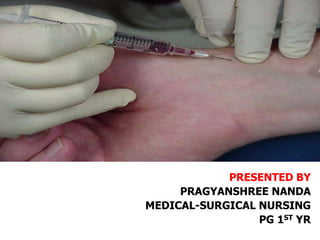
ABG
- 1. PRESENTED BY PRAGYANSHREE NANDA MEDICAL-SURGICAL NURSING PG 1ST YR
- 3. INTRODUCTION • A blood gas test measures the amount of oxygen and carbon dioxide in the blood. It may also be used to determine the pH of the blood • Analysis of arterial blood gases (ABG) is useful for patients with suspected respiratory or metabolic diseases.
- 4. DEFINITION Arterial blood gas (ABG): The sampling of the blood levels of oxygen and carbon dioxide within the arteries, as opposed to the levels of oxygen and carbon dioxide in venous blood. Typically the acidity, or pH, of the blood is measured simultaneously with the gas levels in ABG
- 5. ARTERIAL BLOOD GAS (ABG) • An Arterial Blood gas test measures the acidity (pH) and the level of oxygen and carbon-di-oxide in the blood from the artery. • This is used to check how well the lungs are able to move oxygen into the blood and remove carbon-di-oxide from the blood.
- 6. COMPONENTS OF BLOOD GAS • Oxygen- pao2, sao2, • ventilator- pco2 • acid-base- pH, HCO3 – BE
- 7. COMMON TERMS • PCO2 (ventilation): partial carbon di oxide • PaO2 (Oxygenation): partial Oxygen • HCO3 (metabolism): Bicarbonate • O2 sat : Oxygen saturation • pH : Acid-base balance • BE : Base excess
- 8. Indications Respiratory failure Cardiac failure. Liver failure. Renal failure. Hyperglycaemic. Multiorgan failure. Sepsis. Burns. Poisons/toxins. Ventilated patients. Sleep studies. Severely unwell patients from any cause affects prognosis.
- 10. NORMAL ABG PARAMETER NORMAL VALUE pH 7.35-7.45 PaCO2 35-45 mg/dl PO2 70-100 mg/dl SaO2 ≥ 93% HCO3 22-26 mEq/l BE -2 to +2 mEq/l
- 11. TARGET BLOOD GAS IN NEONATE Paramet ers < 28 weeks gestation 28-40 weeks gestation Term with PPHN Infant with BPD pH ≥7.25 ≥7.25 7.30-7.50 7.35-7.45 Paco2 45-55 45-55 30-40 55-65 Pao2 45-65 50-70 80-120 50-80
- 12. 6 STEPS TO ABG ANALYSIS Is the pH normal? Is the co2 normal? Is the HCO3 normal? Match the co2 or HCO3 with the pH Does the co2 or HCO3 go the opposite direction? Are the pO2 and O2 sat. normal?
- 13. WHAT MAY GO WRONG IN ABG HYPOXIA: ↓ PaO2 ↓ O2 saturation Causes: RDS, pneumonia, cyanotic heart disease, CHF, abnormal hemoglobin
- 14. CONT... ACID-BASE DISORDERS: Primary acid base disorder Respiratory acidosis Respiratory alkalosis Metabolic acidosis Metabolic alkalosis Compensation Mixed acid base disorder
- 15. PRIMARY ACID BASE DISORDER ROME R: RESPIRATORY O: OPPOSITE M: METABOLIC E: EQUAL
- 16. CONT... • Primary acid base disorder: pH PaCO2 HCO3 Respiratory acidosis ↓ ↑ Normal Respiratory alkalosis ↑ ↓ Normal Metabolic acidosis ↓ Normal ↓ Metabolic alkalosis ↑ Normal ↑
- 17. PARTIALLY COMPENSATED ACID- BASE DISORDERS pH PaCO2 HCO3 Respiratory acidosis ↓ ↑ ↑ Respiratory alkalosis ↑ ↓ ↓ Metabolic acidosis ↓ ↓ ↓ Metabolic alkalosis ↑ ↑ ↑
- 18. COMPLICATIONS • Hematoma • Thrombosis and embolism • Infection • Inaccurate blood gas result Excessive heparin may result in a false pH and paco2 Air bubbles may falsely elevate the pao2 and falsely lower the paco2
- 19. SUMMARY
- 21. Quick quiz - 1 • A 17-year-old patient presents to A&E complaining of a tight feeling in their chest, shortness of breath, some tingling in their fingers and around their mouth. An ABG is performed on the patient whilst they’re breathing room air and the results are shown below… pH= 7.8, Pco2= 34mg/dl, po2=70mg/dl, HCO3 = 29 mEq/l • Interprete above blood gas a. Metabolic acidosis b. Respiratory acidosis c. Metabolic alkalosis d. Respiratory alkalosis
- 22. Quick quiz - 2 • A 6 days term baby admitted in NICU with severe respiratory distress syndrome. • ABG report: pH= 7.20, Paco2= 25mg/dl, pao2=70mg/dl, HCO3 = 20 mEq/l. Interprete above blood gas. a. Metabolic acidosis b. Respiratory acidosis c. Partially compensated metabolic acidosis d. Partially compensated respiratory acidosis
- 23. conclusion
